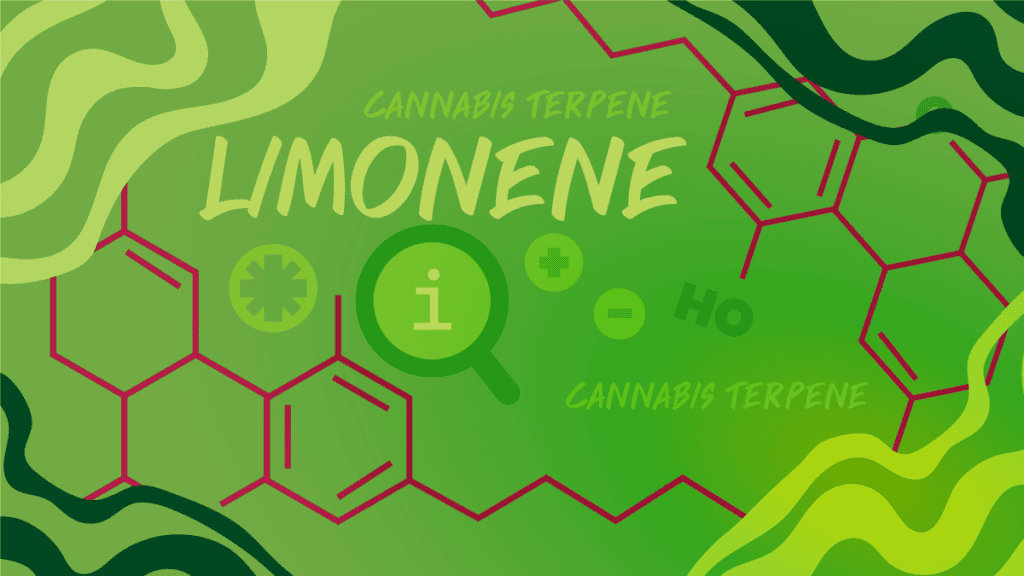- Dispensaries
-
Cultivars
By Cultivar Types
By Effects
By Terpenes
- Blog & Press
- About
- Products
Limonene Cannabis Terpene: Effects, Benefits, Cannabis Strains
- Cenk Cetin
- April 3, 2024
- 1:42 pm
- No Comments

Introduction
Terpenes, as discussed in previous articles, are extremely important organic compounds found all over the planet in plants and animals. Cannabis, especially with modern cross breeding is the richest and most abundant source of a spectrum of terpenes known to humanity.
Terpenes have many uses in nature; to be alluring to animals for pollination purposes, to protect against the sun, for communication between plants, and in the case of the skunk – protection from predators.
Modern cannabis science, despite being held back by misguided laws, has managed to progress to a point where we now know many more useful things about how terpenes and indeed cannabinoids interact with the body and the ecosystem as a whole.
Limonene, or more accurately D-Limonene, is extremely common in both cannabis and the rest of nature. It is in the top 3 most common terpenes found in cannabis, along with beta-caryophyllene and myrcene. Found in citrus fruits, it smells fresh, fruity, sweet and a little tart. In cannabis, flavonoids also help bring the citrus aroma. Limonene, along with specific health benefits like antioxidant or anti-inflammatory properties, is a very uplifting and energising terpene so is usually best dosed in the morning.
Aromatherapy is a big part of wellness and the cannabis experience and terpenes play the lead role. Incorporating terpenes into your life depending on your needs via cannabis, fresh fruit or extracts, can produce a holistic optimisation effect. You know what you need to feel happy and well so you decide on the most beneficial way to get it.
Limonene in Nature
Limonene is the second most commonly found terpene in nature after pinene – found in pine, other conifer trees and many more plants.
Limonene occurs naturally in many places in nature. It occurs in citrus fruits like lemons, limes, oranges, grapefruits and is more concentrated in the skin of these fleshy fruits. Limonene can be extracted from the skin of these fruits to produce therapeutic and aromatic oils. Citrus skin, dried and used as air freshener, is also a very common and old practice.
Limonene is also found in non citrus fruits. It’s found in rosemary, peppermint and juniper among others. Rosemary contains several terpenes also shared with cannabis and is used frequently in cuisine and traditional medicine. Rosemary tea is said to be highly energising, which is helped by the limonene. Juniper is an integral ingredient of gin, which owes much of its taste to limonene and pinene.
When limonene is in the flowers of the plant it can repel or attract insects for pollination, which is a common use for terpenes. Limonene, when exuded underground, from the roots of the plant, slows and prevents growth of other species of plants in the surrounding area.
Limonene in Detail
Limonene is a monocyclic-terpene and not a terpenoid, meaning there is no oxygen in the molecules. The ‘monocyclic’ refers to a ring formation in its structure giving it a higher boiling point than terpenes without one.
Limonene actually has two versions of itself that are like molecular mirror images sort of like your left and right hand. D-limonene or ‘R’ version is the one found in citrus fruits and cannabis. L-limonene or ‘S’ version is not found in cannabis but is found in pine and mint plants giving a distinctive minty aroma. We can see the connection between these two versions in fresh smelling candy or cleaning products based around citrus or mint.
Other limonene derivatives are also very common in nature and cannabis. Carvone, the active ingredient in spearmint seed oil and alpha-terpineol which is found in cardamom and pine, are in the limonene family. Another derivative is 1,8-cineole which is actually the eucalyptus terpene.
Health benefits
Limonene is the happy terpene. It is known to be mood elevating and stress relieving. It can also trigger olfactory memories, like many terpenes, which can induce nostalgia. High bioavailability at 70% which means it works very well just as aromatherapy because simply breathing it in through the air should give you some therapeutic effects.
When combined with THC it is said to have a cerebral and euphoric entourage effect. Limonene has been found to have strong anxiolytic (anti-anxiety) and antidepressant effects. The anti-anxiety effects are thought to be mediated by the serotonin receptors as limonene can increase serotonin levels in the prefrontal cortex and can increase dopamine levels in the hippocampus.
Limonene can also support the immune system and relieve pain through its anti-inflammatory properties, like many terpenes. It helps regulate the balance of resources and energy in the body thus reducing discomfort in the consumer.
These effects that limonene can offer can be achieved through consumption via any source of the terpene. Each source will bring its own entourage effect except isolated limonene, which is essentially orange peel extract. Interestingly, orange oil contains around 90% limonene while lemon oil contains about 68% limonene with 16% b-pinene and 12% g-terpinene.
Pure limonene extract is used for conditions such as acid reflux. It acts as antimicrobial to balance the excess alkaline in the stomach. It is important to dose properly as too much can kill too many bacteria and exacerbate the issue. Side effects can include orange tasting burps.
Limonene has also been found to be anti-cancer. Limonene disrupts the signals being sent to the cancer cells in the tumour. This stops the cells from multiplying and eventually causes their death – this process is called “apoptosis”.
Limonene in Your Wellness Routine
Limonene being an energising terpene means that it can affect your circadian rhythm, which is our cycle of wakefulness and sleepiness. The day or wakeful state is called catabolic – it produces energy and helps break down tissue for regeneration. Anabolic states refer to sleepiness or nighttime state where the body is very good at repairing and rebuilding our body and mind.
Too much catabolic or day state they experience insomnia, loose stools, a rise in insulin resistance and lack of healing time. Too much anabolic state and you can experience constipation, anxiety, tachycardia (fast resting heart rate), or in some cases hard tumours.
Limonene is pro catabolic therefore insomniac or people who are high catabolic might increase their symptoms on consumption. This means the most harmonious time to take limonene is the morning and other terpenes like myrcene or caryophyllene are pro anabolic and more appropriate for night time.
Naturally occurring limonene has been a part of healthy diets around the world for a very long time. The benefits of lemons are famously healthy for a wide range of reasons across many cultures. For specific problems like acid reflux, isolated limonene is great for many people.
In terms of general wellness, fruits, spices and cannabis all contain their own entourage effect which will have its own impact on your system. This shows that if we incorporate herbal knowledge into our wellness routine we can optimise our diets and medication at the same time.
High Limonene Cultivars
The limonene content of a cultivar will have a very significant impact on the level of energising compared to calming. High limonene contents are common in sativa hybrids and sativa landraces. However it can also appear in some indica strains in small amounts.
Kush Mints is a very popular equally balanced hybrid for its relaxing and energising qualities making it perfect for creative tasks. It has a distinctive minty fresh flavour with gassy undertones. Kush mints is perfect for depression and anxiety due to its euphoric effects but is not strongly recommended for insomnia.
Durban Poison is a landrace sativa native to South Africa. It’s very popular for its fruity fresh aroma and its uplifting energising effect. It is also great for creativity and treating depression.
Banana Kush is a hybrid strain also renowned for its energising euphoria. It has a distinctive banana smell and provides a mellow buzz great for anxiety and depression and is good for remaining talkative in social settings.
Ref: Study, leafly, blog, blog
Conclusion
Limonene is an extremely useful terpene. It shows up in fruits and herbs all across the planet as have been in many people’s diets for thousands of years. It’s health benefits were part of ordinary life for much of this time.
We now know that it is the same compound that creates the energising effects in lemon, rosemary, cannabis and much more. Therefore we can organise our own wellness routine around our physical condition, dietary and emotional needs.
There are many strains with limonene, strains with the highest content should be avoided before sleeping and primarily used to raise the mood and energy levels of the consumer.



